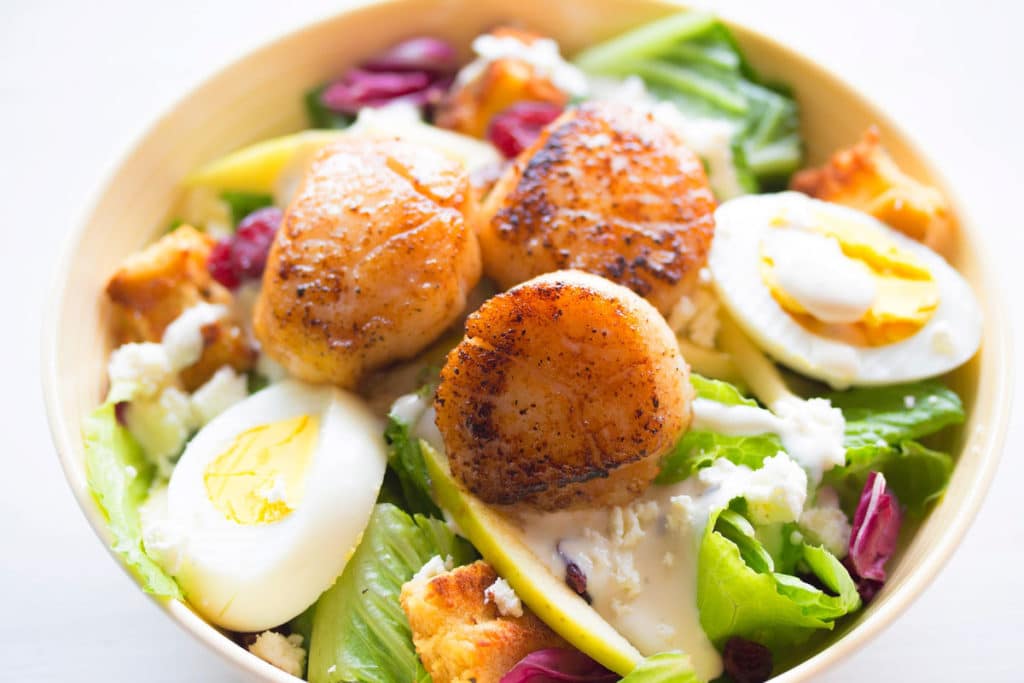
Want to know how to thaw frozen scallops safely and quickly?
This short guide will highlight the 3 best methods to consider, when defrosting this popular seafood.
How to Safely Defrost Scallops
While it is pretty easy to thaw scallops, you need to understand that there is the possibility for food borne illnesses to arise, if you thaw incorrectly and leave the scallops exposed at room temperature for too long.
You need to be aware of what is the ‘Danger Zone’? The Danger Zone, According to the United States Department of Agriculture (USDA), is the range of temperatures 40 ° and 140 °F, where bacteria grows quickly. At those temperatures, the harmful bacteria that can cause food borne illnesses numbers can often double.
To be safe, it is recommended to thaw overnight in the refrigerator.
Overnight in the Fridge: The Safest Way to Thaw Scallops
When you have frozen scallops, thawing them overnight in the refrigerator is the best and recommended way to defrost this seafood. While it is the best, it is also not the quickest option.
What you will not to do is take out the bag/container of scallops and place it on the bottom shelf, to the back of the refrigerator to thaw out.
It is placed on the bottom shelf for Food safety reasons, as you do not want excess liquid to leak from a higher shelf down to the bottom.
The United States Department of Agriculture (USDA) has indicated that defrosted scallops can safely remain in the refrigerator for an extra day or two, once they have been thawed out. They should not be stored any longer.
Related: How to Thaw Salmon?
Microwave: The Quickest Way to Thaw Scallops
If you need to defrost scallops quickly, the microwave is the by far the fastest way, but you need to take caution when using this method.
The microwave works by heating up food and there is a possibility of cooking/overcooking your frozen scallops, if not done correctly.
Even though most microwaves have a defrost setting, there can be uneven thawing that takes place, which is a major food safety concern
Steps
- Place the frozen scallops in a microwave-safe plate/container. (You can also place paper towels to absorb excess moisture, as the scallops thaw)
- Use the microwaves defrost setting or use 30% power. Depending on the size of the package of scallops, it should take 7-8 minutes per pound to thaw this seafood.
- You should keep checking the microwave to ensure that you are not cooking the scallops and that they are defrosting properly..
- Once thawed out, immediately use.
Cold Water: Another Quick Way to Thaw Scallops (If You Have Time)
The cold water method is another quick option (not as fast as the microwave) to look at if you are looking to thaw scallops quickly.
There are two ways you can use cold water, by either submerging the scallops or running them under cold water.
Steps (Running Under in Cold Water)
- Turn on the kitchen pipe to cold and take the packaging and run it under the pipe for a couple of minutes.
- Let the water y run over the frozen bag of scallops, turning the bag throughout the process..
- After couple of minutes, all the scallops should be defrosted ready to be used.
- Use immediately, once thawed.
Steps (Submerging in Cold Water)
- Fill a container with cold water.
- Take the bag of frozen scallops or remove from the bag and immerse in the container of cold water.
- Let the frozen scallops, sit in the water for around 10-15 minutes. Check to see if they have thawed.
- Throw out the old water and add new cold water and let the scallops sit until they are fully defrosted.
- Depending on how big the bag of scallops is, the thawing process could take up to 30 minutes or longer.
- Use immediately, once thawed.
Wrapping it up
When it comes to thawing frozen scallops, there are many options available.
It is important to note that dangers, such as the possibility of food borne bacteria multiplying, if you do not thaw the scallops properly.
With that said, keeping the seafood overnight in the fridge is the best way for it to thaw out, but you can also use the microwave or cold water as quicker options.